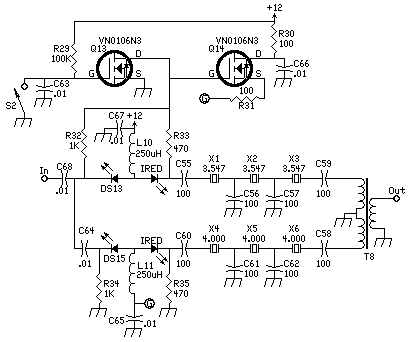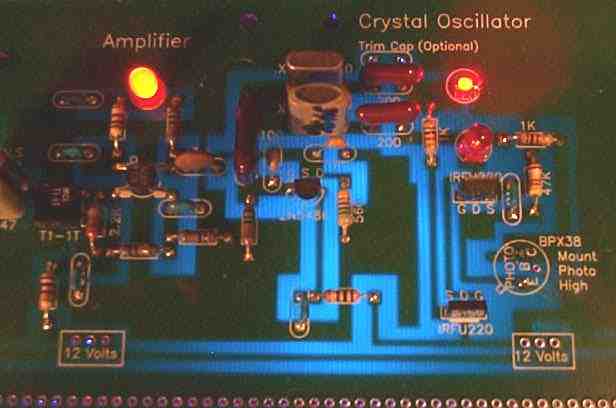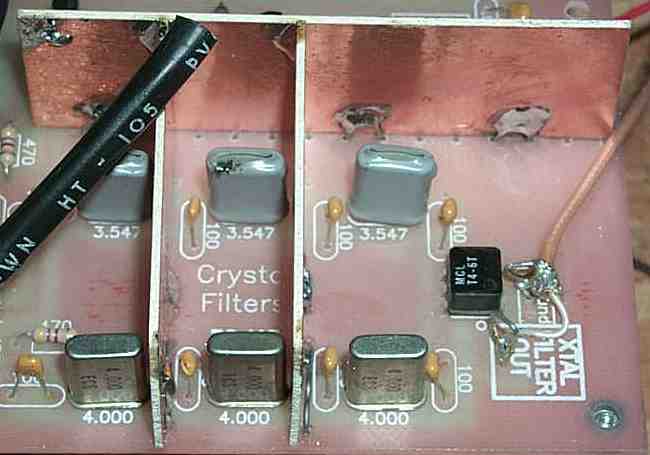


|
The crystal filters are the control center of this receiver. All the important IR (infra-red) action occurs here. Both crystal filters will hit two bands with a technique called band imaging. By using the difference and sum of a crystal filter frequency with a VFO frequency, two amateur bands can be received with each crystal frequency. For an example of this technique, check out the 1988 ARRL Handbook for Radio Amateurs, Chapter 30. "A Band-Imaging CW Receiver for 10 and 18 MHz". |


|

|
The output of this board is the box labeled "Xtal Filter Out", with two soldering pads. The two pads are used to install a loop of wire for easy soldering and unsoldering during building and testing. The "Xtal Filter Out" is attached to the "Xtal Filter In" inside the box of the Second Mixer on the second board. Almost all the spurs in this receiver are the result of the VFO frequency getting into the second mixer. Always use shielded coax between the crystal filter output and the input of the second mixer to keep signal pickup to a minimum. Crystal Filter InputsThe inputs are switched by two LEDs in series, one an LED and the other an IRED which switches the VFO frequency or the crystal oscillator frequency. The two LEDs in series gave the best isolation of all the techniques tried and was easy to implement. While experimenting with the two-LED switching circuit, it was found that LEDs have widely varying capacitance values that effects the loss through the LEDs. Also, the resistance used in the ground circuit of the LEDs makes a large difference. I found the resistance used and the capacitance of the LEDs have a relationship. The first LED in the switch has the most effect on the loss of the switching circuit. A visible LED is used and the resistor value used is 1K, which makes for a bright indicator. The resistor value used with the IREDs is 470 ohm. Lower values increase isolation and lowers the impedance to the crystal filter. For the lowest loss through the switching circuit, use a 2.2K resistor with the LEDs and a 1K resistor with the IREDs. The 1K resistor is probably the maximum value that can be used and still have enough IR energy to switch the phototransistors. The resistors are in the ground circuit of the LEDs. The red LEDs supplied with the kit (the first LED in the switch) have about 5-10pf capacitance. LEDs with low capacitance values provide better isolation between the filters. The super-bright LEDs have a much higher capacitance - approximately 100 to 200pf. A direct replacement of the stock LEDs (bright red) with the Super-brights provides the lowest loss of any of the combinations. You can lower the resistance values to 470 ohms and have the same loss as with the stock LEDs. This provides better isolation with the super brights. This will also increase the brightness of the super-bright LEDs. It appeared that the lower the capacitance value of the LEDs, a higher resistance value was needed to keep losses at a minimum. Higher capacitance LEDs with 2.2K resistors have the least loss, but the isolation goes down slightly. References"Crystal Parameter Measurement and Ladder Cyrstal-Filter Design", QEX, Sept/Oct 2003, by Randy Evans, KJ6PO. Claims to have the easiest program for determining capacitor values for a ladder filter. Input crystal values into a spreadsheet program available at the ARRL QEX download site. Spreadsheet program file is 0309evans.zip. "Ladder Crystal Filter Design", by J. A. Hardcastle, November 1980, QST, Page 20. "A Unified Approach to the Design of Crystal Ladder Filters", by Wes Hayward, W7ZOI, May 1982, QST, Page 21. This was the first article that hinted at the fact that regular computer crystals or color burst crystals could be used in a very effective homebrew crystal filter. "Designing and Building Simple Crystal Filters," by Wes Hayward, W7ZOI, QST, July 1987, P 24. This article showed how using the same capacitance for each capacitor in a crystal ladder filter gave very good results, very inexpensively, and easily adjusted bandwidth. Crystal ladder filters - This page contains JavaScript tools to design and simulate crystal ladder filters which are widely used in SSB transmitters and CW receivers. Could be used to fine tune the xtal filters used in the receiver. Excellent page!
|
Send E-Mail || Amateur Radio Receivers || Electroluminescent Receiver
